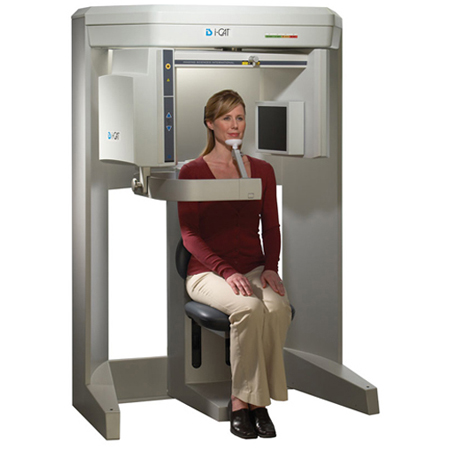Beam me up…
No, this machine isn’t from an episode of Star Trek. It is the latest in dental imaging technology.
This is a 3-D imaging CBCT (Cone Beam Computed Tomography) scanner. A form of x-ray, but one that provides much more detail in the form of advanced digital imaging for dental offices.
While this may look like something from the future, the technology has actually been around for a number of years and is in use in many dental offices around the country.
What’s different about a CBCT scan?
A ‘standard’, individual x-ray and a 2-D panorama x-ray only give flat, 2-dimensional pictures. They cannot see inside the bone or get a lot of detail.
A CBCT scan gives a 3-D picture of bone and soft tissue, showing details that no flat x-ray can. It can cover a much larger area of the head and neck than just the teeth. The scan can then be manipulated in the dentist’s computer to view structures from various angles. By providing imaging both bone and soft tissue at the same time, more information is provided. This allows the dentist to do a more precise job of diagnosing and treatment planning.
Several dental specialties utilize cone beam technology.
A periodontist, prosthodontist, or any dentist who does implants, can actually use software that is linked into the CBCT scanner to help him/her place an implant with a degree of precision that could not be achieved using a regular x-ray.
Endodontists also utilize this technology to precisely see what is needed for a root canal treatment and where the roots, nerves and blood vessels are. It can also detect a dental root fracture with much greater accuracy.
Orthodontists may also use it as part of treatment planning.
Other areas where a CBCT scan is used are:
Diagnosing TMJ/TMD disorders
Imaging impacted teeth to determine the best way to remove them
Evaluation of the jaw, sinuses, nerve canals and nasal cavity
Detecting, measuring and treating jaw tumors
Locating the origin of pain or disease
Reconstructive surgery
A CBCT scan is fast.
One of the great features of a CBCT scan is that it is fast. No more holding individual film pieces in your mouth in different awkward and sometimes uncomfortable postilions while the hygienist takes multiple x-rays. A CBCT scan takes from 10 – 40 seconds, depending on how much of the head and neck structures are imaged – and is totally painless.
A CBCT scan is much lower radiation than a CT scan.
While dental x-rays have always been among the lowest dose x-rays you are likely to receive in a health care setting, CBCT scans, while providing a great deal more detail, are only slightly more. The amount of radiation received will vary by type of scanner used, what is being scanned (some areas require more radiation to ‘see’ results) and how large an area is being scanned.
A CT scan that you would receive in a hospital setting (mammogram, chest, or abdominal, for example) can expose a patient to from ten to several hundred times more radiation than a CBCT scan.
What are the advantages of a CBCT scan?
With a CBCT scan, your dentist can see more detail. This includes detail of not only your teeth, but also your bones, nerves and blood vessels and their positions relative to each other. This can be extremely important for root canal treatments and implant placement.
What is the difference between a CBCT and a CT or CAT scan?
In a hospital setting you might receive a CT (also called a CAT) scan. The image is derived by taking individual x-ray ‘slices’ through the part of the body being imaged. A computer program then ‘fills in’ the gaps between the sections and produces the finished image. It also subjects you to a large amount of radiation.
A CBCT scan, on the other hand, circles around the head. making a continuous image. There are not ‘slices’ to be put together by a computer. The operator sets the CBCT scanner to only use higher doses of radiation to image the areas of interest, not the whole head and neck, thereby reducing overall radiation exposure. The result is a more accurate picture of the problem area in question and lower radiation.
References:
https://bit.ly/2DX8DTR
https://bit.ly/2G7Kfot


Another very important benefit of the CBCT is identification of airway deficiencies and sinus conditions to name a few, that would contribute to breathing disorders. It enables following progress of bone growth and airway enhancement during and following these treatments. Very valuable tool indeed.
Very Informative